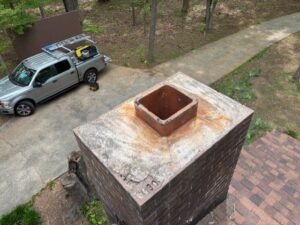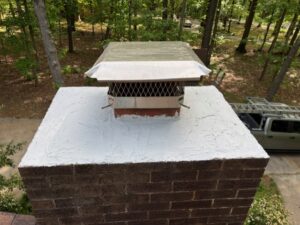There are several types of fireplaces that are frequently installed in homes in America. Previously full masonry chimneys were the most common, but in recent years several types of prefabricated chimneys have become popular due to cost and ease of installation.
Full masonry fireplaces consist of many parts to make them function properly and most important, safely. The hearth, which extends in front of the firebox prevents hot ash from encountering combustibles. The firebox, made of firebrick, which holds the fire and provides radiant heat into the home. The damper, which controls air flow up the chimney. The smoke chamber and flue tiles, which exhaust the smoke and gases out of the firebox. The crown, which allows water to flow away from the top of the chimney, preventing penetration and deteriorating the chimney from the inside. Finally, the cap, which all chimneys should have one, but many do not, to keep out rain, birds, animals and to act as a spark arrestor.
I would like to focus on the crown and the cap for this post, starting with the crown. The crown covers the top of the masonry chimney around the flue tiles and extends to the edge of the bricks, and in some cases extends past the bricks. This allows water to flow off the top of the chimney. The crown may be made of poured concrete or in many warmer areas, mortar is used to create the crown, sometimes called a “mortar wash.” Over time and exposure to the elements, the crown may begin to crack and deteriorate. This will allow water to penetrate and slowly degrade the bricks and mortar from the inside. If not addressed promptly this can result in costly repairs.
The chimney cap is a vital component and should be installed on every chimney. Water is one of the most damaging elements, outside of a chimney fire, to a chimney. A properly installed cap can prevent a significant amount of water from entering the flue tiles. This over time reduces degradation of the flue tiles and smoke chamber. The cap will also prevent birds and animals from accessing the chimney. This can result in minor nuisance’ such as Chimney Swifts on an annual basis, to costly service charges for removing live or dead animals that can’t get out of the chimney.
Proper maintenance is key to keeping your fireplace functioning properly and safely. If you don’t have a cap or haven’t had your crown inspected, it’s time to check that “to do” item from your list. This small investment now will prevent larger expenditures in the future.

chimney crown before

After-repaired chimney crown- with cap
